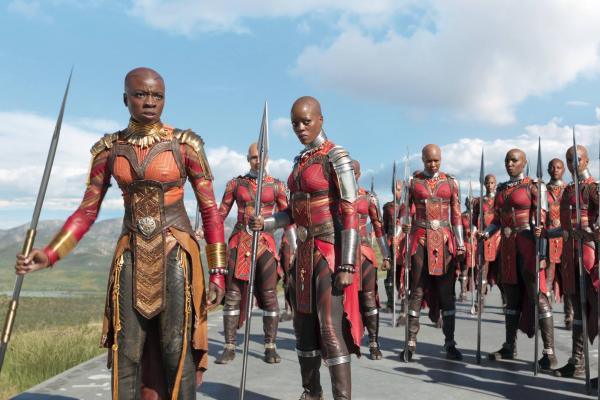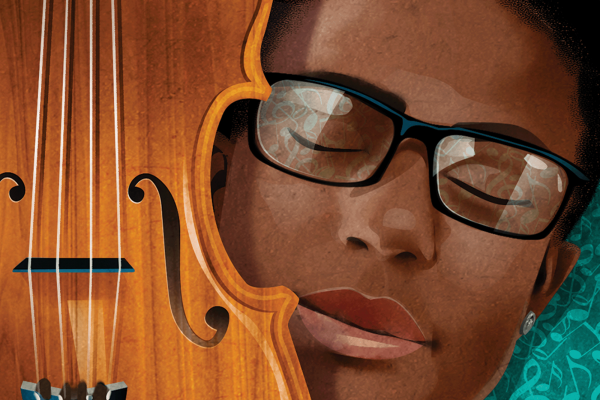“In times of crisis, the wise build bridges, while the foolish build barriers. We must find a way to look after one another, as if we were one single tribe.” —T’Challa, King of Wakanda, Black Panther
As of this week, Black Panther, the latest installment in the Marvel Universe, has made more than $1 billion worldwide. This may not sound unusual for those who look at this film as nothing more than a cinematic adaption of a comic book character. But the film has struck a nerve worldwide in offering a complex and compassionate rendering of people of African descent through the lens of Afrofuturism.
“Afrofuturism” is a term coined by music critic Mark Dery and popularized by sociologist Alondra Nelson to describe artistic engagement in which people of African descent break free of racialized limitations, by creating new possibilities through art, literature, music, and film, with people of color as central agents for human flourishing. In other words, black people are able to envision a past, present, and future free from a tradition of narrative tropes that only see people of color as props for telling a story.
The chord Black Panther strikes is not just that there are black people on screen, but how these people of color are captured on screen. D.W. Griffith’s seminal film The Birth of a Nation in 1915 introduced “cinematic tropes,” mythological stereotypes designed to infect white and black minds with a defective view of black capacity and creativity. Griffith offered the world grotesque images that, to this day, still sully the imagination of black children, and subconsciously form the foundation of retrograde public policy surrounding voting rights and incarceration.
The tropes are as follows (with a few modern revisions): the Buck, the Mammy, the Coon, the Uncle Tom, the Tragic Mulatto, and the Magical Negro.
Film scholar Donald Bogle spent his academic career examining American cinematic history, from The Birth of a Nation to the present, and discovered that these characters appear consistently in films made about black people — and even in films created by black people.
The “Buck” character designed by Griffith was a physically powerful black male, who was also hypersexual. This character sought to violate the virtue of white Southern women — thus, the heroes of Griffith’s film, the Ku Klux Klan (yes, the KKK were defined as heroes in the film), had to lynch or incarcerate this dangerous black man. Griffith also offered the “Coon,” usually a black male, whose sole purpose on screen was to make the audience laugh at his foolish actions. Ignorant, lazy, and quick-witted, the character was created to calm white fears, and announce that there are some black men who are safe and child-like; whose purpose is to bring laughter to the plantation. The “Mammy” was a female character designed for comedy — usually with a dark complexion, overweight, fussy, and physically strong, she was often seen putting the “Coon” character in his place. This “Mammy” character has evolved over the years, but is placed in films to protect white interests. The “Uncle Tom” character was driven by a need to inform the establishment about “uppity” black characters who desired to be freed from white control. The “Tragic Mulatto” was cast as woman of lighter complexion, desired by men, with the unique caveat that she must be saved from her own infantile choices and context by a male, usually a white character.
The newest trope is the “Magical Negro,” a black character whose divine-like calling in a film is to bring enlightenment to the protagonist on his/her journey of self-discovery.
All these tropes have haunted the silver screen since 1915. African-American and African characters have rarely, until recently, fully broken free. When they do, they do so in creations by independent filmmakers, who finance their projects outside the traditional Hollywood system.
This is the basis for why Black Panther has become a phenomenon. Our church, Trinity United Church of Christ, took nearly 1,500 people to witness the power of what, on the surface, seems to be a typical Hollywood comic book blockbuster. But beneath the surface is a complex tale of Afrofuturism, responsibility to the vulnerable, questions of liberation, and the role of women. Ryan Coogler, the 31-year-old auteur who took the helm of the project, made artistic decisions that make this film worth discussing far beyond typical comic book geekdom.
The story is located in Wakanda, a beautiful technologically advanced nation in Africa, which has the largest deposits of the worlds most precious metal on Earth, vibrainum. This context makes Wakanda the world’s most advanced civilization and the wealthiest nation in the Marvel Universe. Coogler, with costume designer Ruth E. Carter and production designer, Hannah Beachler, covered the cast — including Chadwick Boseman, Michael B. Jordan, Lupita Nyong’o, Danai Gurira, Angela Bassett, Letitia Wright, and Daniel Kaluuya — in the fabric of Africa. Through the Amhara people of Ethiopia, the Akan of West Africa, the Maasai of Eastern Africa, and the Xhosa of South Africa, we are given a stylistic feast of the Pan-African fashion aesthetic: beautiful, vibrant colors; natural hair; and stories within stories on the fabric of the characters.
The world of Wakanda, though fictional, opens up the viewer’s imagination. We witness people of African descent not through the lens of suffering, but as complex characters who are seeking answers to universal questions, including: What is the moral responsibility of a community to those who suffer? What are the tools required to lead in an age of isolation and xenophobia?
Black Panther answers these questions beautifully. We witness T’Challa, the king of the nation, leaning on the council of women — a wise mother, Queen Ramonda; a spy and compassionate former girlfriend, Nakia; an engineer and brilliant sister, Shuri; and a thoughtful general, Okoye, all women who are strong, intelligent, graceful, funny, and deeply committed to teaching and mentoring the king. When have we witnessed this dynamic on film? To experience male-female relationships as complimentary, not competing, dramatic narratives is in itself refreshing and subversive to the dominant stories offered to the public about black people. These women are not tropes who must be saved by a man, nor a strange exaggerated stereotype borrowed from D.W Griffith’s destructive model. They are family committed to the growth of this village by highlighting the moral anchors of the community: compassion, commitment, just action, and spiritual reflection. These are the images I want my daughter to witness, and my son to digest. I want my daughter to envision being a Shuri, a brilliant, self-assured scientist; or a reflective, committed, humble, and strong military leader like Okoye. I want my son to value the gifts of women who bring intelligence, leadership, and insight to the community.
The finest cinematic moment in the film is the interplay between Michael B. Jordan’s character Erik Killmonger and Chadwick Boseman’s King T’Challa. Killmonger embodies all of the heartbreak, passion, and rage of black American injustice. He is a product of American exploitation and Wakanda’s indifference to his plight. His character grapples with a blurry vision of liberation. T’Challa and Killmonger are deeply connected, each offering the other a piece of the puzzle of what it means to be a servant and leader to a people privileged and to a people oppressed. It is a stunning way to frame a conflict. The so-called villain, Killmonger, is not truly a villain but a deeply wounded yet brilliant man, yearning for Wakanda while simultaneously hearing the cries of his people suffering globally.
This is where Coogler shifts gears from the traditional blockbuster film. He challenges the viewer, and black people in particular, not to choose between Erik and T’Challa, but to find a way to integrate them both into our hearts. Coogler’s genius is his ability to bring these images to the screen while giving the viewer blockbuster thrills connected to wider moral questions.
This is why our community joined in the celebration of the film. Not just to wear African fabric, but to use this film as an educational platform for our youth. We have created a study guide for families, and offered classes on faith and film. I have preached on the topic “Wakanda,” raising the critical moral question, “How do we take the limits off the imagination of black children in Chicago?”
Part of the answer is to create more Afrofuturism. Let our children dream, and dream big. Faith communities must be temples of imagination and possibility, where girls and boys can take off the tropes of the world and clothe themselves with the garment of possibility. This is the power of Black Panther. As I stated to our community on Sunday, “Wakanda forever!”
Got something to say about what you're reading? We value your feedback!







